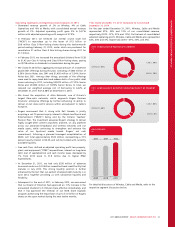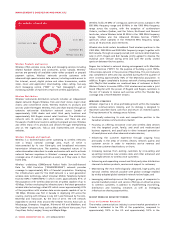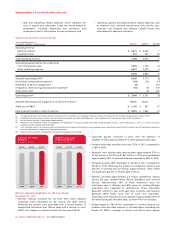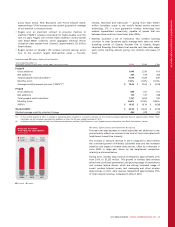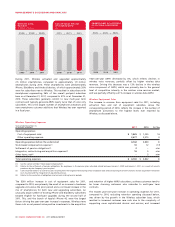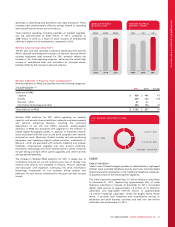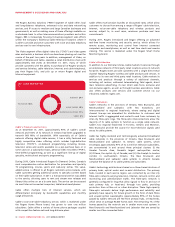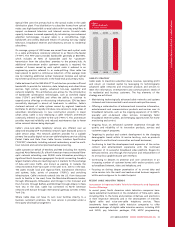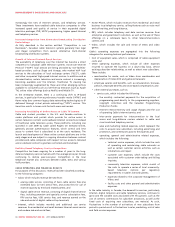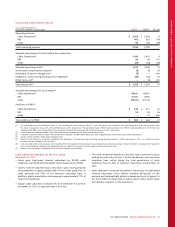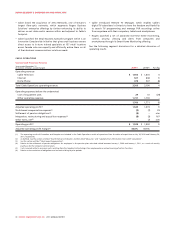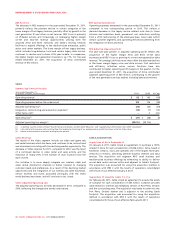Rogers 2011 Annual Report Download - page 36
Download and view the complete annual report
Please find page 36 of the 2011 Rogers annual report below. You can navigate through the pages in the report by either clicking on the pages listed below, or by using the keyword search tool below to find specific information within the annual report.
MANAGEMENT’S DISCUSSION AND ANALYSIS
The Rogers Business Solutions (“RBS”) segment of Cable offers local
and long-distance telephone, enhanced voice and data networking
services, and IP access to medium and large Canadian businesses and
governments, as well as making some of these offerings available on
a wholesale basis to other telecommunications providers and within
Rogers. RBS is increasingly focusing its business segment sales efforts
within the Company’s traditional cable television footprint, where it
is able to provide and serve customers with voice and data telephony
services over its own infrastructure.
The Video segment offers digital video disc (“DVD”) and video game
sales and rentals, a business which we have been phasing out over the
course of the past two years. In addition, management of Video, on
behalf of Wireless and Cable, operates a retail distribution chain with
approximately 360 stores at December 31, 2011, many of which
provide customers with the ability to purchase all of Rogers’ products
and services (wireless, cable television, Internet, and cable telephony),
pay their Rogers bills, and pick up or return Rogers digital and
Internet equipment.
(%)
2011 CABLE REVENUE MIX
TELEVISION 50%
INTERNET 24%
BUSINESS SOLUTIONS 11%
HOME PHONE 13%
VIDEO 2%
Cable’s Products and Services
As at December 31, 2011, approximately 90% of Cable’s overall
network and 100% of its network in Ontario had been upgraded to
transmit 860 MHz of bandwidth. With essentially all of Cable’s
network offering digital cable services, it has a richly featured and
highly competitive video offering, which includes high-definition
television (“HDTV”), on-demand programming including movies,
television series and events available on a per-purchase basis or in
some cases on a subscription basis, personal video recorders (“PVR”),
time-shifted programming, as well as a significant line-up of digital
specialty, multicultural and sports programming.
During 2010, Cable introduced Rogers On Demand Online, Canada’s
most comprehensive online destination for primetime and specialty
TV programming, movies, sports and web-only extras. This value-
added service is offered to all Rogers customers across Canada, with
Cable customers getting additional access to specialty content based
on their cable subscription. In 2011, a transactional section was added
to the service, allowing users to rent and stream new releases and
library titles online on an a la carte basis. The service can be accessed
via most Internet connected computers, tablets and smartphones.
Cable offers multiple tiers of Internet services, which are
differentiated principally by bandwidth capabilities and monthly
usage allowances.
Cable’s voice-over-cable telephony service, which is marketed under
the Rogers Home Phone brand, has grown to over one million
subscribers. Cable offers a variety of home phone packages coupled
with competitive feature sets and long-distance plans.
Cable offers multi-product bundles at discounted rates, which allow
customers to choose from among a range of Rogers’ cable television,
Internet, voice-over-cable telephony and wireless products and
services, subject to, in most cases, minimum purchase and term
commitments.
During 2011, Rogers introduced and began offering an advanced
real-time home monitoring and security service, which allows for
remote access, monitoring and control from Internet connected
computers and smartphones, as well as real time alerts and remote
viewing. This service is marketed under the Rogers Smart Home
Monitoring brand.
Cable’s Distribution
In addition to our 360 retail stores, Cable markets its services through
an extensive network of third party retail locations across its network
footprint. Rogers stores provide customers with a single direct retail
channel featuring Rogers’ wireless and cable products and services. In
addition to its own and third party retail locations, Cable markets its
services and products through a variety of additional channels,
including call centres, outbound telemarketing, field agents, direct
mail, television advertising, its own direct sales force, exclusive and
non-exclusive agents, as well as through business associations. Cable
also offers products and services and customer service via our
e-business website, rogers.com.
Cable’s Networks
Cable’s networks in the provinces of Ontario, New Brunswick, and
Newfoundland and Labrador, with few exceptions, are
interconnected to regional head-ends, where analog and digital
channel line-ups are assembled for distribution to customers and
Internet traffic is aggregated and routed to and from customers, by
inter-city fibre-optic rings. The fibre-optic interconnections allow the
majority of its cable systems to function as a single cable network.
Cable’s two regional head-ends in Toronto, Ontario and Moncton,
New Brunswick provide the source for most television signals used
across its cable systems.
Cable has highly-clustered and technologically advanced broadband
cable networks in the provinces of Ontario, New Brunswick and
Newfoundland and Labrador. Its Ontario cable systems, which
encompass approximately 91% of its 2.3 million television subscribers,
are concentrated in and around three principal clusters: (i) the
Greater Toronto Area, Canada’s largest metropolitan centre;
(ii) Ottawa, the capital city of Canada; and (iii) the Guelph to London
corridor in southwestern Ontario. The New Brunswick and
Newfoundland and Labrador cable systems in Atlantic Canada
comprise the balance of its cable systems and subscribers.
Cable’s technology architecture is based on a three-tiered structure of
primary hubs, optical nodes and co-axial distribution. The primary
hubs, located in each service region, are connected by an inter-city
fibre-optic network carrying television, Internet, network control and
monitoring and administrative traffic. The fibre-optic network is
generally configured in rings that allow signals to flow in and out of
each primary hub, or head-end, through two paths, providing
protection from a fibre cut or other disruption. These high-capacity
fibre-optic networks deliver high performance and reliability and
generally have capacity for future growth in the form of dark fibres
and unused optical wavelengths. Approximately 99% of the homes
passed by Cable’s network are fed from primary hubs, or head-ends,
which serve on average 90,000 homes each. The remaining 1% of the
homes passed by the network are in smaller more rural systems in
New Brunswick and Newfoundland and Labrador that are served by
smaller non-fibre connected hubs.
32 ROGERS COMMUNICATIONS INC. 2011 ANNUAL REPORT



